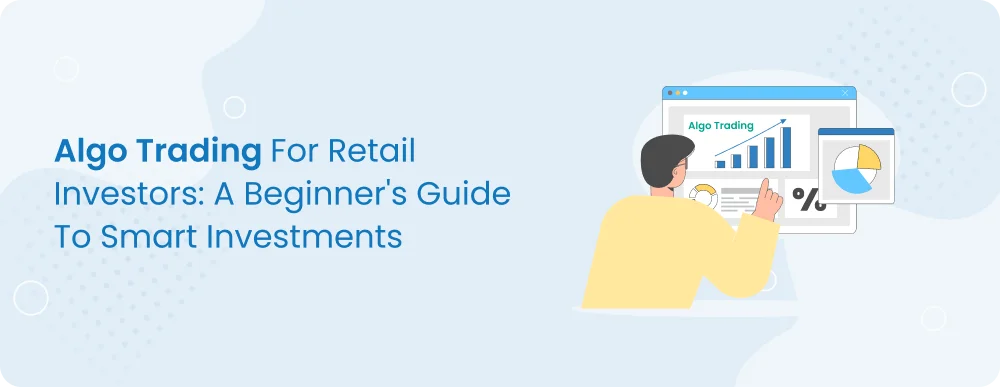Algo Trading for Retail Investors: A Beginner's Guide to Smart Investments
Noor Kaur
18 Nov 2024Tags:
Featured
Algorithmic trading, often called algo trading, uses computer programs to execute trades based on predefined criteria. This streamlines your trading process, allowing you to execute orders faster and more efficiently.
In this guide, you’ll learn about various algo trading strategies to help you easily trade. Read along!
What Is Algorithmic Trading?
Algorithmic trading, also known as automated trading or algo trading, uses computer programs to execute trades based on specific instructions called algorithms. These instructions are designed to identify trading opportunities and make decisions at speeds and frequencies too fast for any human trader to match.
How Algorithmic Trading Works
To understand how algorithmic trading functions, let’s look at an example. Suppose you have a strategy that states: buy 100 shares of a stock when its 100-day moving average rises above its 200-day moving average and sell those shares when the opposite happens.
In this scenario, you can implement algo trading to continuously monitor the stock price and these moving averages, executing trades automatically when the criteria are met.
Advantages and Disadvantages of Algorithmic Trading
Here’s a closer look at the pros and cons of algorithmic trading:
Pros of Algorithmic Trading
- Trades are often executed at the most favourable prices available in the market.
- Orders are placed instantly and accurately, helping to avoid significant price fluctuations.
- Algorithms eliminate emotional biases, ensuring decisions are based solely on data and logic.
Cons of Algorithmic Trading
- Delays in executing trades can lead to missed opportunities and potential losses.
- Technical issues or failures can disrupt the trading process, resulting in losses.
- Large algorithmic trades can influence market prices and increase volatility.
- Algorithms may not account for qualitative factors, which can impact market movements.
- Developing and maintaining algorithmic trading systems can be costly.
Algorithmic Trading Strategies
Here are some common types of algo trading you might consider:
Trend-Following Strategies
Trend-following strategies involve identifying and capitalising on market movements in a particular direction. Traders analyse historical price data to detect trends, buying during upward movements and selling during downward trends.
Arbitrage Opportunities
Arbitrage opportunities arise when an asset is priced differently in two or more markets. Traders exploit these discrepancies by simultaneously buying low in one market and selling high in another.
Index Fund Rebalancing
Fund managers use index fund rebalancing to maintain the target asset allocation index fund. This involves periodically adjusting the fund’s holdings to align with the benchmark index while minimising tracking errors.
Mathematical Model-Based Strategies
Mathematical model-based strategies use quantitative methods and algorithms to inform trading decisions. Traders develop mathematical models that analyse market data, identify patterns, and generate trading signals.
Trading Range (Mean Reversion)
Based on mean reversion, trading range strategies assume that prices will revert to their average over time. Traders identify price levels where an asset frequently oscillates and buys at lower levels while selling at higher levels, profiting from these periodic fluctuations.
Volume-Weighted Average Price (VWAP)
VWAP is a trading benchmark that reflects a security's average price based on price and volume. Traders use VWAP to ensure that their trades align with the average price throughout the trading day, often striving to buy below the VWAP or sell above it for better execution prices.
Time Weighted Average Price (TWAP)
TWAP is a strategy that executes orders over a specified period to achieve an average price. This approach helps traders minimise the impact of large orders on the market, distributing trades evenly across time to reduce price volatility and slippage.
Percentage of Volume (POV)
POV is a strategy that allows traders to execute orders as a percentage of the market's trading volume. By aligning their orders with the overall market activity, traders can ensure they participate in the market without creating significant price movements.
Implementation Shortfall
Implementation shortfall measures the difference between a trade's expected return and the actual return achieved after executing it. Traders use this strategy to analyse their trades' effectiveness, aiming to minimise costs and improve execution efficiency.
Beyond the Usual Trading Algorithms
Apart from these algo trading strategies, a class of algorithms is known as sniffing algorithms. Primarily used by sell-side market makers, these algorithms are designed to detect the presence of algorithms on the buy side of large orders. By identifying these signals, market makers can capitalise on large order opportunities, often filling orders at higher prices.
Technical Requirements for Algorithmic Trading
Implementing algorithmic trading involves several technical requirements to ensure successful execution and profitability. These include:
- Proficiency in programming languages (like Python or C++)
- Reliable internet access is necessary for seamless connectivity to trading platforms
- The ability to backtest the algorithm with historical data
- Access to real-time market data feeds
The Bottom Line
By understanding various types of algo trading, you can tailor your approach to meet your investment goals. Plus, algo trading software allows you to execute trades quickly and precisely, minimising human error and maximising opportunities. As you explore automated trading for beginners, remember to test and refine your strategies through backtesting and real-time practice.
Frequently Asked Questions
What is algorithmic trading, and how does it work for retail investors?
Algorithmic trading is using computer algorithms to execute trades based on predetermined criteria. For retail investors, it involves using algo trading software to automate trading strategies, enabling them to trade efficiently without needing constant manual intervention.
Is algorithmic trading legal?
Yes, algorithmic trading is legal in most jurisdictions, provided that traders adhere to regulations set by financial authorities. However, traders must ensure their activities comply with local laws and market regulations to avoid penalties.
How do I learn algorithmic trading?
Learning algorithmic trading typically involves studying programming languages, understanding market mechanics, and practising automated trading for beginners' courses or resources. Many platforms offer tutorials and simulations to help new traders develop effective algo trading strategies.
What are some common risks involved in algo trading?
Common risks in algorithmic trading include software malfunctions, poor strategy performance, and market volatility. Traders must carefully monitor their algorithms and be prepared to adjust their best algo trading strategy to mitigate potential losses.
Can you make money with algorithmic trading?
Yes, it is possible to make money with algorithmic trading. Still, success depends on the effectiveness of the chosen algo trading strategies and the trader's ability to adapt to market changes. Retail investors can benefit from using robust algo trading software to increase their chances of profitability in online trading for beginners.
Noor Kaur
18 Nov 2024Related blogs


Intraday Trading Strategy: Open High Open Low Approach
Intraday trading is one of the most exciting and rewarding types of online stock trading. As a day trader, you sho...


Understanding NISM Certification : Everything You Need to Know | mastertrust
In today's world, more and more people are getting curious about finance and the world of money. It doesn't matter...


Seeking Better Returns Than FDs? Explore These Options | mastertrust
Fixed deposits are a popular investment choice because of their guaranteed returns and safety.


Role of Inflation in Long-Term Investment Planning
In Financial Planning, one of the things that plays a key role is the impact of inflation on your investments.
Sign up to our newsletter !
Share this article on
Recent articles
Tags:
Open a Demat Account in just 15 minutes !

Click on open
account below

Fill out some
basic details

Upload your
documents

Start trading in
24 Hours *
Commonly asked questions
Is Master Capital Services Limited SEBI registered?
Do you have a mobile app for Trading and Finance Management?
What services does mastertrust provide?
What is the minimum investment required to start trading with your company?
Is my personal and financial information secure with your company?
What is your customer support availability?





